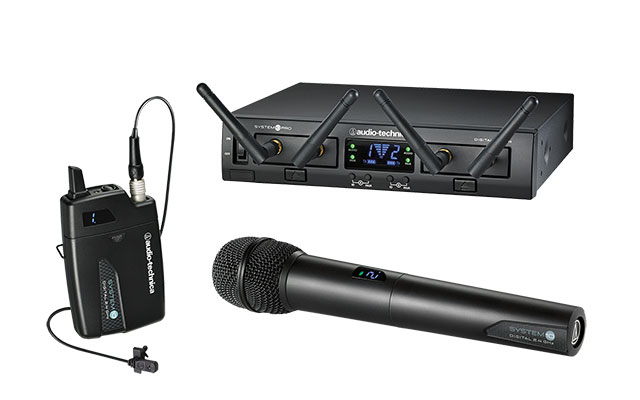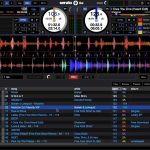Digital Wireless: Audio-Technica’s upgrade.
To begin at the end, let me say that I have literally zero past experience with Audio-Technica microphones. I have been a fan of their high-fidelity phonograph cartridges for decades and have had good luck with their headphones, in both studio and DJ settings. But being a user of other microphone brands, I never had the occasion to try out A-T mics.
So… the team at Audio-Technica sent me a set-up from its new System 10 PRO line – the ATW-1312/L, including the ATW-RC13 dual rack-mount receiver chassis, two ATW-RU13 receiver units, an ATW-T1001 UniPak transmitter and an MT830cW lavaliere mic, plus an ATW-T1002 handheld microphone/transmitter. This system utilizes an all-digital, 24-bit/48 kHz audio pathway on the 2.4 GHz band, making it completely free from TV and DTV interference.
The System: The unit I received has a dual-channel, half-space, fully mountable chassis, a clear LED display showing RF signal level, system ID, transmitter-battery level, system-link status, and which ID number you are pairing on. The rear panel includes AC power, a volume knob (recommended by Audio-Technica to set to maximum in typical use), and dual balanced and unbalanced outputs.
In my testing—even in busy downtown hotels with tons of RF interference—I never had to do anything more than turn on the unit and microphones to get them to pair, but there are very easy-to-follow instructions to troubleshoot in more challenging set-ups.
Layout: The new modular design of the receiver is well-planned. By pressing the release buttons on the front, you can pop out the receiver units, which you can attach via Ethernet cable (up to 328 feet long) to locate the receivers at a distance from the chassis, which is beneficial in so many ways. No matter where you choose to set up, you now have a way to mitigate interference quickly and easily—such a good idea.
The handheld unit has an on/off/mute button on the bottom, which was easy to operate, maybe even a bit too easy – as a few times speakers hit the button when passing the mic. The UniPak is similarly straightforward, though we noted it took a little longer than the mic to power on after pressing the button. Overall, the cardioid mic felt good and was, in fact, lighter than most microphones I use on a regular basis.
In Practice: The ATW-1312/L worked well in our testing. In a setting where I have had issues before—a busy hotel in downtown Boston with a ton of wireless Internet, cell phones, and Bluetooth devices nearby—the unit performed flawlessly. The sound quality was also notable—bright without being harsh and a ton of presence. I was able to get the same results with much less “gain” than other mics. I was able to attain strong results at 250 feet from the base unit, much more than I would ever need in the real world.
I had two issues with the unit, which took a small bit of the shine off an otherwise exceptional experience. The first was down to battery life, as my unit sucked the power from a pair of brand new AA batteries in less than four hours. The unit also lost power quickly and went from two bars to dead without much warning.
The other issue I had was an amount of handling noise. Holding the handheld mic and speaking using proper mechanics was fine and, if I have the chance to mount this on a stand and have users employ the mic hands-free, these could be mitigated, but that kind of defeats the purpose of a wireless mic. But, on occasion, having multiple speakers pass the mic back and forth could be a distracting experience.
Conclusions: The Audio-Technica ATW-1312/L wireless system with which I was provided has a MAP of $849 and comes in many other configurations. Small issues aside, I was very pleased with the performance. Sound quality was excellent, set-up hassle free, and overall the system feels sturdy and roadworthy.
The ability to pair 10 transmitters per receiver, extend the range via Ethernet cables, and the other upgraded features should make this wireless system appealing to a lot of people. This is definitely a system worth considering for your wireless needs.
If you have any questions for Sounding Off, please send them to djtimes@testa.com.








